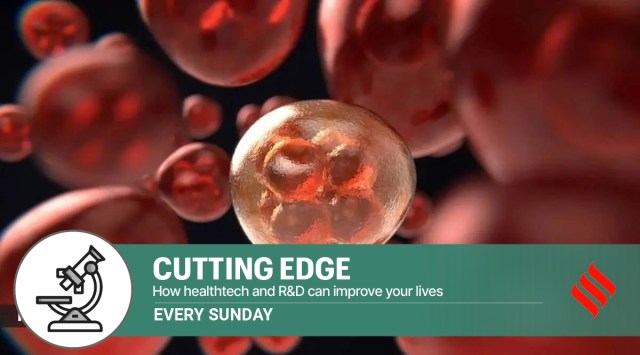How a nano knife can find and kill the smallest of cancer cells
‘The needles are placed in or around a tumour. And then you have to pass very high voltage electricity between any two needles at a time. This process punctures very small holes into the cell membranes which result in cell death,’ says Dr Sanjay Saran Baijal, Chairman, Diagnostic and Interventional Radiology, Medanta, Gurugram
 The huge advantage of using this technology is that it spares blood vessels (Source: Freepik)
The huge advantage of using this technology is that it spares blood vessels (Source: Freepik) When 57-year-old Kishan, a patient suffering from non-alcoholic steatohepatitis — liver inflammation resulting from an excessive fat accumulation in the organ — was getting a routine CT scan done, he had not bargained for cancer. During the process, doctors at Medanta, Gurugram, detected a lesion in his kidneys, which turned out to be a malignant tumour.
This came as a shock to Kishan as prior to the CT scan, he did not have any symptoms of cancer. Initially, the doctors adopted a multi-disciplinary approach. Since it was a renal cancer, the urologist became the mainstay of the treatment strategy. The team consisted of the urologist, the liver specialists who were managing his other co-morbidities and the diagnostic and interventional radiology team.
Usually when someone has cancer, the job of the surgeon is to operate and remove the cancer, ensuring clean margins. However, in this case, it was a renal cancer and the urologists were not keen on surgery because they felt the patient was not fit to undergo a surgical procedure on account of his chronic liver disease and associated ailments. Therefore, an alternative method to manage the tumour needed to be adopted. This is when they suggested using the Nano knife as it would totally ablate and destroy the cancer. Post the procedure, the patient is doing very well.
What is a nano knife? How does it work?
According to Dr Sanjay Saran Baijal, Chairman, Diagnostic and Interventional Radiology, Medanta, it comprises a set of filaments that are positioned around the tumour. “The needles are placed in or around a tumour. And then you have to pass very high voltage electricity between any two needles at a time. This process punctures very small holes into the cell membranes because of which the cells die while the peripheral tissues are left intact. Therefore, this has to be done with very accurate deployment of the needles. Since it is high voltage electricity, the procedure has to be done under full general anaesthesia and the needles have to be placed with such absolute accuracy that you need imaging guidance. Hence ultrasound and CT scans are the imaging modalities that are used for deployment of the needles,” he says.
Are there any eligibility criteria for the patient?
Dr Baijal says the patient has to be fit for general anaesthesia. Second, he has to ideally have no pacemaker implanted in him. “Because there will be so much electricity passing through, we don’t want any disturbance in the pacemaker function. But other than that, there is no other criteria because the nano knife allows surgeons to treat tumours which are otherwise very, very difficult to reach,” he says.
What are the advantages?
The huge advantage of using this technology is that it spares blood vessels. It’s very precise and targeted. It will not harm the blood vessels even if they are in close vicinity of the tumour or even sometimes within the tumour. Some reports say that the success rate has been around 95 per cent.
Is there a particular type of tumour that a nano knife is used for?
The device is used to remove small tumours of up to 3 centimetres in size. “If you look at the worldwide usage of Nano knife, you would find it mostly being used for treating pancreatic cancer, which we otherwise couldn’t because it was deemed surgically unresectable. It is also used in tumours of the liver and kidney,” says Dr Baijal. Pancreatic cancer is difficult to diagnose in the early stages when it’s more treatable. By Stage 3, it is too advanced to be removed surgically and the patient risks a spread. In such cases, the nano knife has almost doubled the life expectancy for pancreatic cancer patients, according to institutions in the West using it.
Is the nano knife procedure better than any of the other existing procedures?
Dr Baijal says that there are ablative procedures which are performed using needles, for example radio frequency ablation or microwave ablation or cryoablation. “The first two require heating of the tissues and effectively burning them. The last one requires lowering the temperature and actually freezing the tumour to death. And a nano knife has the great ability of being non-thermal. It’s the passage of electricity which makes nano pores in the cell membrane that cause cell death while simultaneously sparing a lot of critical structures which might be in the vicinity,” he adds.
- 01
- 02
- 03
- 04
- 05































